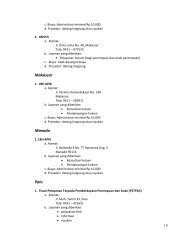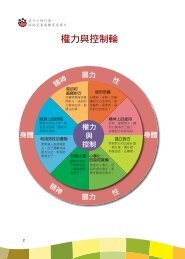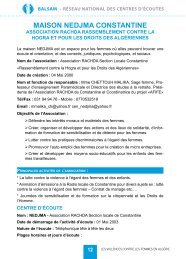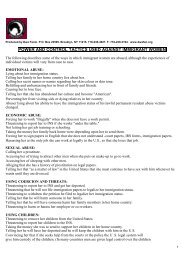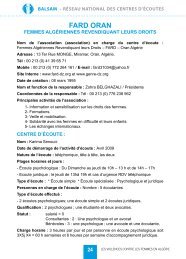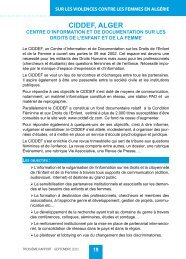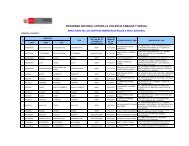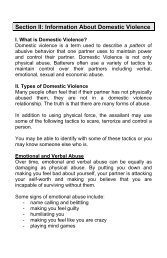Working with Battered Women: a Handbook for ... - Hot Peach Pages
Working with Battered Women: a Handbook for ... - Hot Peach Pages
Working with Battered Women: a Handbook for ... - Hot Peach Pages
Create successful ePaper yourself
Turn your PDF publications into a flip-book with our unique Google optimized e-Paper software.
III.DOCUMENTATIONThorough documentation of the nature and severity of the injuries as well as any statementsmade by the woman about the perpetrator, time, date, location of the event are important legaldetails that may be used at a later date in civil or criminal proceedings. Proper documentation canmake the difference between getting a conviction or the abuser going free, between a woman beingconvicted of murder or your documentation helping to prove she was acting in self-defence, as wellas in custody/access actions involving vulnerable children. And medical documentation of adoctor's or nurse's suspicions of abuse, even if denied by the patient, will be important observationsthat could alert a subsequent nurse or doctor to the possible presence of wife abuse if the womandisplays suspicious injuries or symptoms at some future date.Essential Points to Document• Location and severity injuries, both past and present. Use a body map (page after next)to indicate where on the patient's body each injury or area of tenderness is located.Take photographs of the woman's injuries.• The woman's account of the incident.• The abuser's name or names (there may be more than one).• Details of previous violent contacts the abuser has had <strong>with</strong> the patient.• Police in<strong>for</strong>mation (i.e., police officer's name, identification number), if relevant.• Telephone numbers where the patient may be reached, or the telephone number of aclose friend or relative who would be able to contact her.• Emotional as well as physical symptoms.• Any additional non-physical indications of abuse, such as torn or damaged clothing.• The whereabouts and safety of the patient's children.In taking the photographs, there are some specific and detailed procedures to follow:• Discuss the fact that the photographs will be important legal evidence. (Even if she isnot considering criminal or civil action now, she may at a later date.)• Obtain her written consent to take the photographs and keep the signed consent on file.• Try to ensure that her face or hand <strong>with</strong> a ring on it appears in as many pictures aspossible.• Use a scale such as a small ruler or a coin to provide verification of the size of theinjury.26



